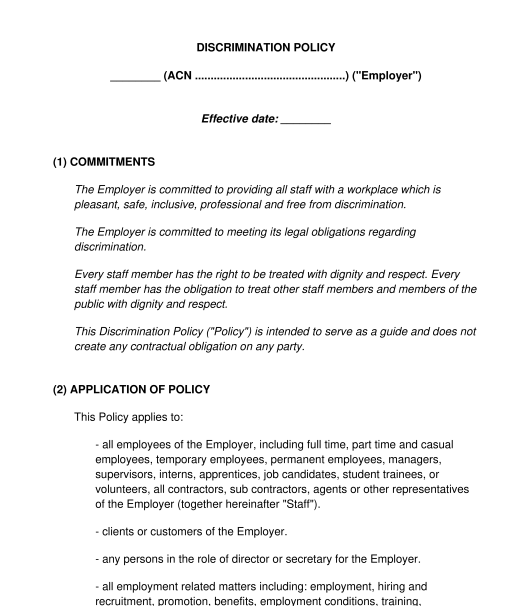 17/09/2025
17/09/2025

Answer a few questions and your document is created automatically.

Your document is ready! You will receive it in Word and PDF formats. You will be able to modify it.

 17/09/2025
17/09/2025
 Word and PDF
Word and PDF
 7 to 10 pages
7 to 10 pages
A Discrimination Policy is a document which can be provided by employers to employees, to inform them of how bullying, harassment, victimisation and discrimination are treated by the employer and what the employees' rights and obligations are in relation to these matters.
It can include a description of each of these types of behaviour, so that employees know what to look out for. It can also explain what the Employer's role is in relation to these matters, so that employees know when and how to seek support or report an issue, and who to speak to. It can also explain what may happen if an employee breaches the Discrimination Policy.
Employers in Australia have a legal obligation towards all employees to provide a safe workplace which is free from bullying, harassment, victimisation and discrimination. Therefore, employers can take steps to address this obligation by implementing an effective Discrimination Policy.
An Employee Handbook is a comprehensive document which deals with a wide range of matters at the relevant workplace. It may touch on discrimination-related matters but will not usually go into as much detail as a Discrimination Policy does.
A Discrimination Policy is specifically focussed on discrimination-related matters so it usually goes into more detail than an Employee Handbook does. In addition, simply having a standalone Discrimination Policy sends an important message to employees that the employer takes these matters very seriously.
It is not mandatory for an employer in Australia to have a written Discrimination Policy, but it is strongly recommended that they have one.
Employers are required by law to provide a workplace that is free from bullying, harassment, victimisation and discrimination. Having a formal Discrimination Policy that is set out in writing and communicated clearly to employees helps to ensure that employees are informed about acceptable behaviour, complaint processes and support. It also helps to demonstrate the employer's compliance with its obligations and to help the employer defend themselves if they are ever alleged to have breached these obligations.
In addition to this Discrimination Policy, there are various other employment policies that employers should consider, such as:
Usually senior members of staff will prepare the Discrimination Policy. This could involve senior managers or directors, or a human resources officer.
There is no expiry date for a Discrimination Policy so it can remain in place indefinitely. However, it should be reviewed regularly to ensure that it is up to date with current laws and with the organisation's current practices.
Once a Discrimination Policy is ready, it should be printed and/or saved electronically and kept on file with the employer, and employees should be made aware of it. For example, any existing employees should be notified of it and given a copy of it. Many employers use a Letter to Employees about New or Updated Workplace Policies to do this. In addition, each time a new employee starts work with the employer, the new employee should be given a copy of the Policy.
In addition, it is a good idea to keep the Policy in a place where it is easy for employees to refer to it - for example, physical copies could be kept in communal areas such as staff rooms. It could also be made available online, for example on the employer's shared drive.
If the employer is getting employees to sign this Policy, the employer should get each employee to return a signed signature page, and should keep those signed pages on file.
From time to time, if the employer implements new rules or procedures, it may be necessary to update the Policy. When this occurs, the employer may notify employees of the updates, and release a new version of the Policy. The employer may ask employees to sign a new signature page at that time, to acknowledge the updated Policy.
In a Discrimination Policy, the employer informs employees about acceptable behaviour, complaint processes and support systems. The employer should ensure that the document accurately reflects their actual approach to these matters. This may cover such matters as:
It is important that this document accurately reflects the employer's actual approach to bullying, harassment, victimisation and discrimination.
Having an accurate and up to date Policy is an important step for employers to take, but in addition to this, they should make sure they are aware of their obligations under Australian law. In some cases, employers may be required to set up systems or processes in the workplace to make sure that employees are protected from bullying, harassment, victimisation and discrimination. Further information is available from the Australian Human Rights Commission, or the employer may seek legal advice.
The following legislation affects bullying, harassment, victimisation and discrimination in Australia:
Each state and territory has legislation in relation to work health and safety. Further information is available from Safe Work Australia.
In addition, the Fair Work Act 2009 (Commonwealth) deals with other employment matters such as unfair dismissal.
You fill out a form. The document is created before your eyes as you respond to the questions.
At the end, you receive it in Word and PDF formats. You can modify it and reuse it.
Guides to help you
Discrimination Policy - sample template - Word and PDF
Country: Australia